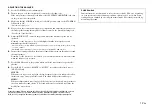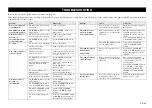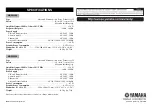
1
En
In 1988, Yamaha brought to the marketplace speaker systems utilizing YST (Yamaha
Active Servo Technology) to give powerful, high quality bass reproduction. This technique
uses a direct connection between the amplifier and speaker, allowing accurate signal
transmission and precise speaker control.
As this technology uses speaker units controlled by the negative impedance drive of the
amplifier and resonance generated between the speaker cabinet volume and port, it creates
more resonant energy (the “air woofer” concept) than the standard bass reflex method. This
allows for bass reproduction from much smaller cabinets than was previously possible.
Yamaha’s newly developed Advanced YST II adds many refinements to Yamaha Active
Servo Technology, allowing better control of the forces driving the amplifier and speaker.
From the amplifier’s point of view, the speaker impedance changes depending on the sound
frequency. Yamaha developed a new circuit design combining negative-impedance and
constant-current drives, which provides a more stable performance and clear bass
reproduction, without any murkiness.
Today’s bass reflex speakers use a Helmholtz resonator to improve their bass reproduction.
However when reproducing bass that is in the frequency region of this Helmholtz
resonator, air moves violently in and out through the port between the interior and exterior
of the speaker, sometimes producing noise due to the turbulent air flow at the end of the
port.
The port and the cabinet resonate at a frequency that is determined by their dimensions and
shape. On the other hand, turbulence in the air flow at the end of the port contains a broad
range of frequency components that are not present in the input signal. This noise occurs
because the broad range of frequency components includes components that match the
resonant frequencies of the port and cabinet, causing strong resonance.
The Twisted Flare Port developed by Yamaha changes the way in which the port widens
toward its end, and also adds a “twist” to suppress airflow turbulence at each end of the port
and thus prevent noise from occurring.
This eliminates the “muddy sound” and “wind noise” that until now have been
characteristic of bass reflex speakers, allowing bass to be reproduced clearly.
ADVANCED YAMAHA ACTIVE SERVO TECHNOLOGY II
High-
amplitude
bass sound
Port
Cabinet
Advanced impedance
Converter
Active Servo
Processing
Amplifier
Signals of low amplitude
Air woofer
(Helmholtz resonator)
Signals
Twisted Flare Port






































